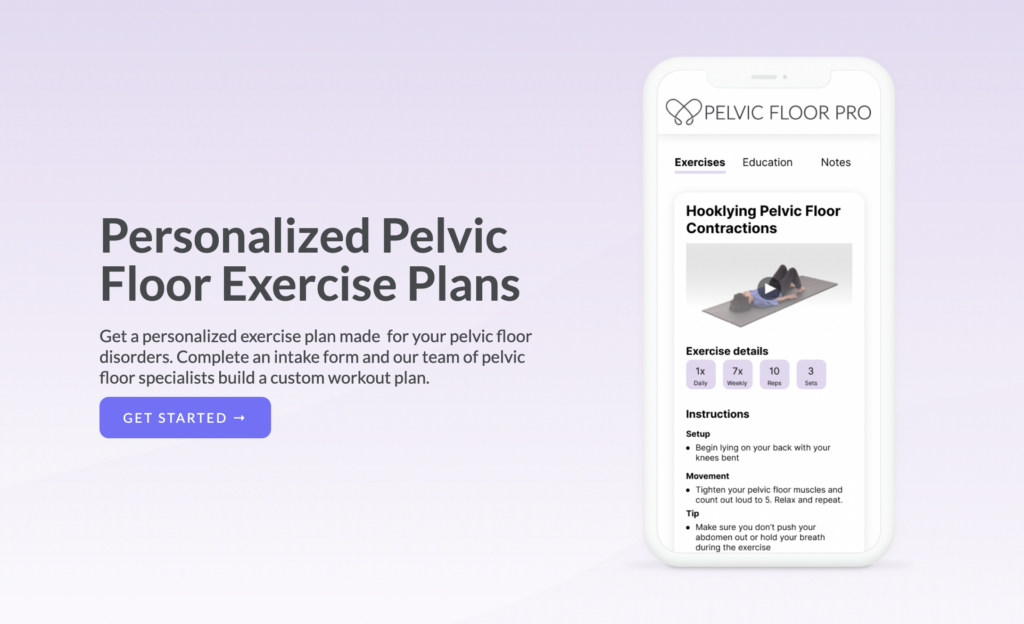
Constipation is something that can affect anyone at any point in their lives. This common bowel problem is treatable, however, there are many people who suffer from chronic compensation which can cause severe discomfort and inconvenience in their lives.
The symptoms of constipation centre around the inability to pass stools. This can leave the sufferer straining to make a bowel movement, and when they do manage to pass anything, they may not manage to empty their bowels fully.
Where someone experiences a long history of constipation, the pelvic floor muscles can be weakened. Pelvic floor muscles help you to control your bowel movements. If these muscles become weak due to incompetence, these can be remedied by strengthening them through exercises.
Related Posts
Comprehensive pelvic floor telehealth sessions from the comfort of your home.
Get Personalized Therapy for Your Pelvic Floor Dysfunction
Improve pelvic floor dysfunction symptoms in only 2 – 3 months from home.
With targeted exercise alone most women can improve their pelvic floor function in 60 to 90 days. Generic exercises won’t get these outcomes, only personalized plans based on your symptoms. This is why intake forms and professional plans are so important.
Learn more with the button below.
Exercise 1- Identifying Your Pelvic Floor Muscles
In order to strengthen your pelvic floor muscles, sit down in a comfortable position with your legs apart slightly. Your first step will be to identify the muscles that you will be exercising.
To identify the back of your pelvic floor, tighten the muscle around your back passage as though you are attempting to prevent yourself from passing wind. You should feel a movement in your muscle.
For the front pelvic floor, imagine that you are about to pass water and imagine stopping the flow of urine. Again, you should feel a muscle pulling. This is the front of your pelvic floor.
Exercise 2- Long Hold
Slowly tighten both the front and the back pelvic floor muscles at the same time. You will feel them pulling upwards. Hold them in the tensed position for up to ten seconds and then relax your muscles again. Wait for around five seconds and then tense the muscles again. Hold the muscles again for around ten seconds.
Repeat this five times in a row. Do this at least three times a day. As you become more comfortable and confident in your ability to do this, you can increase the number of repetitions from five up to twelve at a time. You can also start to gradually increase the amount of time that you hold the muscle in the tensed position.
Exercise 3 – Increasing Speed
As with the previous exercise, you will perform this exercise by pulling on the front and back pelvic floor muscles. This time, you will pull up on the muscles quickly. Then, immediately release them.
As with the long hold exercise, start off by doing these in groups of five, and increase the number of repetitions as you feel comfortable until you are doing ten repetitions at a time.
What You Should Consider When Carrying Out Pelvic Floor Muscle Exercises
When you are building up the strength in your pelvic floor muscles by completing exercises, you should ensure that you are doing these every day. Ideally, try and do both the long and the shorter exercises three times each day.
As and when you feel comfortable, make sure that you increase the number of repetitions that you are doing. On the long hold exercise, you can even extend the amount of time that you hold the muscle in the position. You should only increase the number of repetitions as you feel comfortable to do so. Remember, this is not a race, and improvement will occur over a period of time and should not be rushed. You should take care to ensure that you do not overdo it and cause further damage to the muscle. If your muscles start to ache, stop the exercises and take a break.
When you are carrying out the exercises it is important that you do not hold your breath. Breath naturally by taking deep breaths in and long breaths out. Ensuring your breathing is natural will prevent you from tightening other muscles in your buttocks, tummy, and legs, which you are doing the exercises.
Even if you start to feel the benefits and see an improvement in the strength of your pelvic floor muscles, it is important that you continue with the exercises. Maintaining strength will be very important.
What is pelvic floor therapy for constipation?
Pelvic floor therapy for constipation involves a series of muscle exercises coupled with breathing and relaxation techniques. Pelvic floor therapy teaches you how to use your pelvic floor muscles again while rebuilding any lost strength in the area.
Do pelvic floor exercises help with constipation?
Your pelvic floor muscles can become weak for a number of reasons. This includes childbirth and bowel problems. Chronic constipation will affect your pelvic floor muscles. Regularly exercising your pelvic floor muscles will help you to regain the strength that you need in them. This will help you to regain greater control over your bowel movements.
Can weak pelvic floor muscles cause constipation?
If you have weak pelvic floor muscles caused by childbirth, surgery, or through bowel problems, this can bring about constipation. If you are not able to tighten or relax the pelvic floor muscles, then it can be difficult for you to control your bowel movements.
Chronic constipation can also be a cause of weak pelvic floor muscles.
In order to strengthen these muscles again, you should complete pelvic floor muscle exercises at least three times a day. This should be done on an ongoing basis.
Can Kegel exercises help constipation?
Pelvic floor exercises are also known as kegel exercises. These can be a very effective way of managing the symptoms of constipation while improving the control that you have over your bowels. These can be done by both men and women of all ages, regardless of your overall health levels.
What exercises are good for constipation?
In addition to pelvic floor exercises, you can incorporate a range of other exercises into your lifestyle. If your fitness levels are generally quite good, you may want to include some aerobic exercises such as jogging, swimming, or even taking up dance classes. If you are less physically fit, activities that encourage you to stretch your body such as yoga will be very beneficial.



